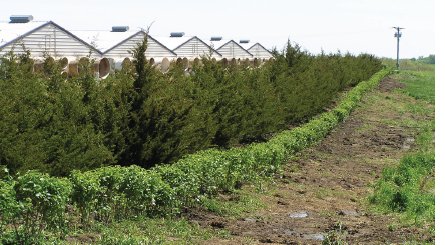AgEBB-MU CAFNR Extension
Green Horizons
Volume 20, Number 3
September 2016
Agroforestry
A Windbreak to Mitigate Odor and More
By H. E. 'Gene' Garrett | Center for Agroforestry and
By Dusty Walter | UMC Ag. Expt. Sta.
Vegetative Environmental Buffer (VEB) design and use for odor mitigation, animal welfare, and energy savings around livestock operations has taken on new prominence in recent years. While they may also be called windbreaks or shelterbelts (all are agroforestry practices), the purpose is the same regardless of the name. Trees, shrubs and grasses are strategically placed in association with livestock operations, especially Confined Animal Feeding Operations (CAFO), to filter, purify, disperse and, in general, reduce odors, while providing protection for the animals and creating a more visually pleasing appearance. Studies have demonstrated that the public is more receptive to CAFO's that are screened through the use of trees than those that are not. VEB's alone will not eliminate odor problems associated with confined feeding operations, but they will effectively reduce them and positively impact public perception.
 |
A CAFO operation with a VEB of Viburnum, redcedar and willlow |
Most odorous chemicals and compounds become attached and are carried on particulate matter (e.g., dust) that originates in or around livestock feeding operations. Because of this, the odor tends to remain close to the ground as it disperses. Properly positioned plant material (trees, shrubs and grasses) can effectively intercept and filter out much of the particulate matter due to their complex leaf shapes and large leaf surface areas. Studies have shown that as much as 35 to 55 percent of dust particles in moving air can be removed by VEB's. This interception is especially important, as it helps reduce odor movement. Also of major importance is the vertical mixing of the odor-laden particulate matter as it rises up and over the VEB and mixes with the air above. Turbulence encountered above the VEB enhances the mixing, creating a dilution effect as the odor plume continues to rise and disperse. Furthermore, a "quiet zone" for a distance of about 8-to-10 times the height of the tree row downwind of the windbreak, allows particulate matter and odor to settle out.
VEB design is very important. The effectiveness of a VEB is determined by its width (number of rows), length, continuity, orientation (if not continuous around the animal facility), height, density and beauty. In addition, overall success is very dependent upon choosing the right species to plant. Species selected for use must be matched to the site being planted. Considerations are, the soil type, precipitation, site drainage characteristics, and natural range of each shrub and tree species. Three-to-five rows of trees and shrubs are normally recommended to provide winter protection for livestock and maximize the mitigation of odor. Since conifers have a greater ability to absorb air pollutants and provide winter protection than deciduous species, one-to-two rows of conifers should be included. However, the number of rows is not as important as the density created. Typically, a VEB should provide a density of approximately 60% (60% of the wind is deflected over the VEB and 40% passes through it). In addition to odor management, and animal protection, this density can significantly reduce the seasonal cost of heating and cooling confined animal facilities.
Upwind VEB's will reduce the amount of dust and odor that is picked up and transported by the wind, while downwind VEB's further control the wind speed and allows particles laden with odor to be filtered and settle out. Because odors tend to collect near the ground, excessively tall trees are not required if properly positioned and oriented. Heights of 18-to-36 feet are adequate for intercepting and diluting odor plumes while providing physical protection for open-feedlots and CAFO buildings.
In Missouri, the USDA, Natural Resources Conservation Service currently recommends a minimum of 3 rows. One row must be a conifer and adequate spacing between rows is required (20 - 50 feet). Financial assistance through EQIP is available for VEB's even though they are called windbreaks/shelterbelts, and can be applied to cover a large portion of the costs associated with their establishment and maintenance. Coverage for containerized planting stock and temporary irrigation is authorized. The installation must follow the NRCS's Windbreak/Shelterbelt Establishment Conservation practice standard (CPS). Contact your local or state NRCS office for more details.
